2008 MERCEDES-BENZ SL ROADSTER wheel
[x] Cancel search: wheelPage 24 of 317
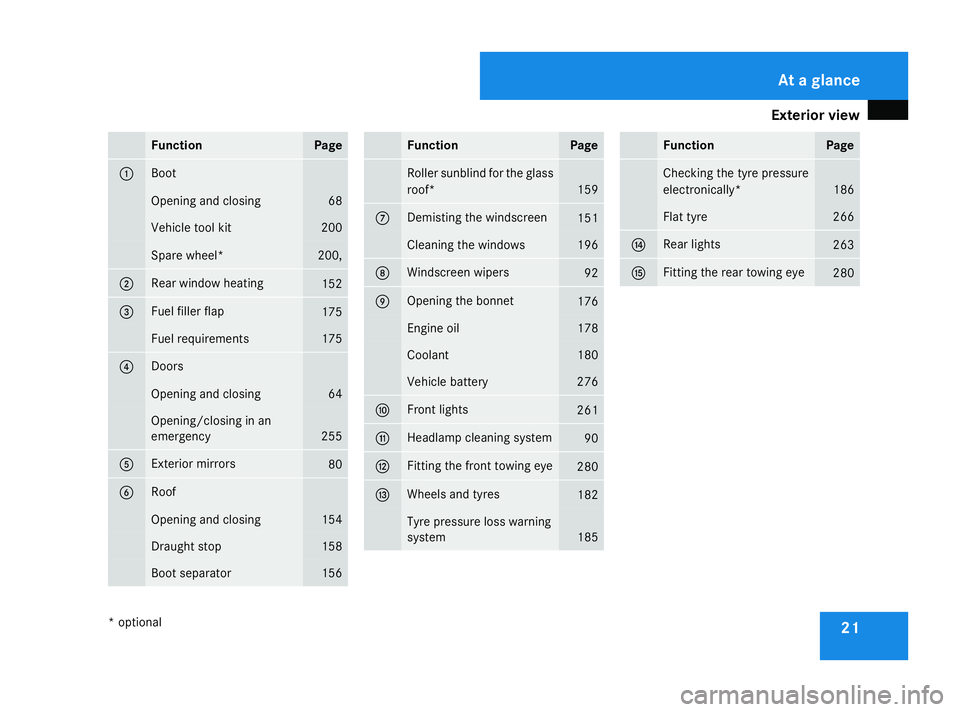
Exterior view
21Function Page
1 Boot
Opening and closing 68
Vehicl
etoolkit 200
Spare wheel* 200,
2 Rear window heating
152
3 Fuel fille
rflap 175
Fuel requirements 175
4 Doors
Opening and closing 64
Opening/closing in an
emergency
255
5 Exterio
rmirrors 80
6 Roof
Opening and closing 154
Draught stop 158
Boot separator 156 Function Page
Roller sunblin
dfor th eglass
roof* 159
7 Demisting th
ewindscreen 151
Cleaning th
ewindows 196
8 Windscree
nwipers 92
9 Opening th
ebonnet 176
Engin
eoil 178
Coolant 180
Vehicl
ebattery 276
a Fron
tlights 261
b Headlamp cleanin
gsystem 90
c Fitting th
efront towin geye 280
d Wheels and tyres
182
Tyre pressur
eloss warning
system 185 Function Page
Checkin
gthe tyrep ressure
electronically* 186
Flat tyre 266
e Rear lights
263
f Fitting th
erear towin geye 280At
ag lance
*o ptional
230_AKB
;5;4,en-GB
bjanott ,V ersion: 2.9.6
2008-04-08T15:09:54+02:00
-Seite 21 Dateiname: 6515_3089_02_buchblock.pdf; preflight
Page 26 of 317
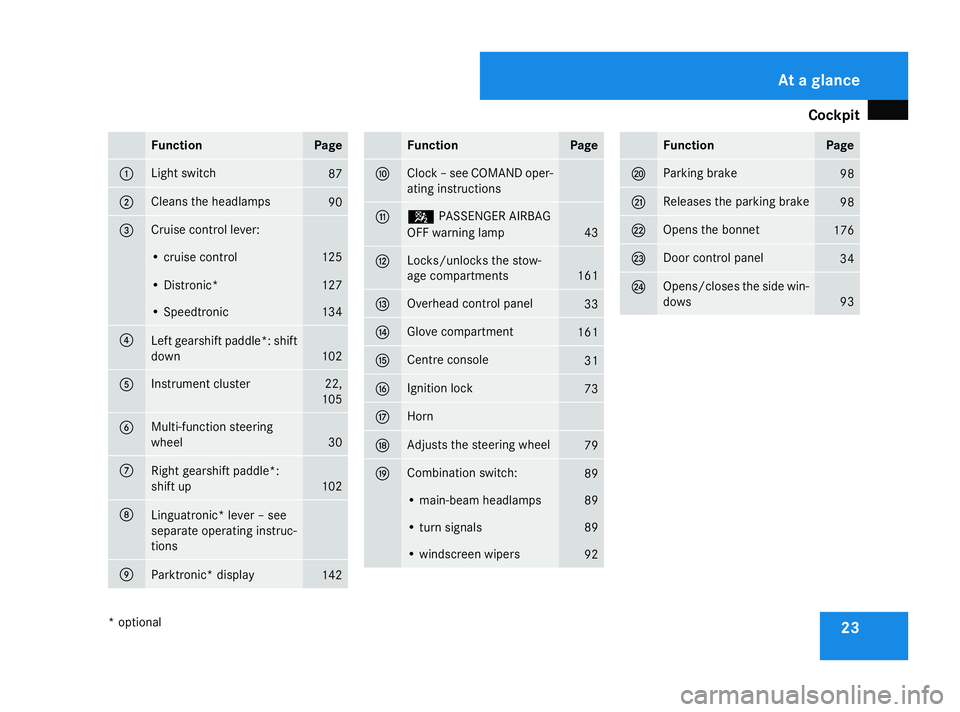
Cockpit
23Function Page
1 Light switch
87
2 Clean
sthe headlamps 90
3 Cruis
econtro llever: •c
ruise control 125
•D
istronic* 127
•S
peedtronic 134
4
Lef
tgearshif tpaddle *: shift
down 102
5 Instrumen
tcluster 22,
105 6 Multi-function steering
wheel
30
7
Right gearshift paddle*:
shift up
102
8
Linguatronic
*lever –see
separat eoperating instruc-
tions 9
Parktronic
*display 142 Function Page
a Clock
–see COMAND oper-
atin ginstructions b 5
PASSENGER AIRBAG
OFF warnin glamp 43
c Locks/unlocks the stow-
age compartments
161
d Overhead control panel
33
e Glove compartment
161
f Centre console
31
g Ignition lock
73
h Horn
j Adjusts the steerin
gwheel 79
k Combination switch:
89
•m
ain-beam headlamps 89
•t
urns ignals 89
•w
indscreen wipers 92 Function Page
l Parking brake
98
m Releases the parking brake
98
n Open
sthe bonnet 176
o Doo
rcontrol panel 34
p Opens/closes the side win-
dows
93At
ag lance
*o ptional
230_AKB; 5; 4, en-GB
bjanott
,V ersion: 2.9.6
2008-04-08T15:09:54+02:00
-Seite 23 Dateiname: 6515_3089_02_buchblock.pdf; preflight
Page 28 of 317
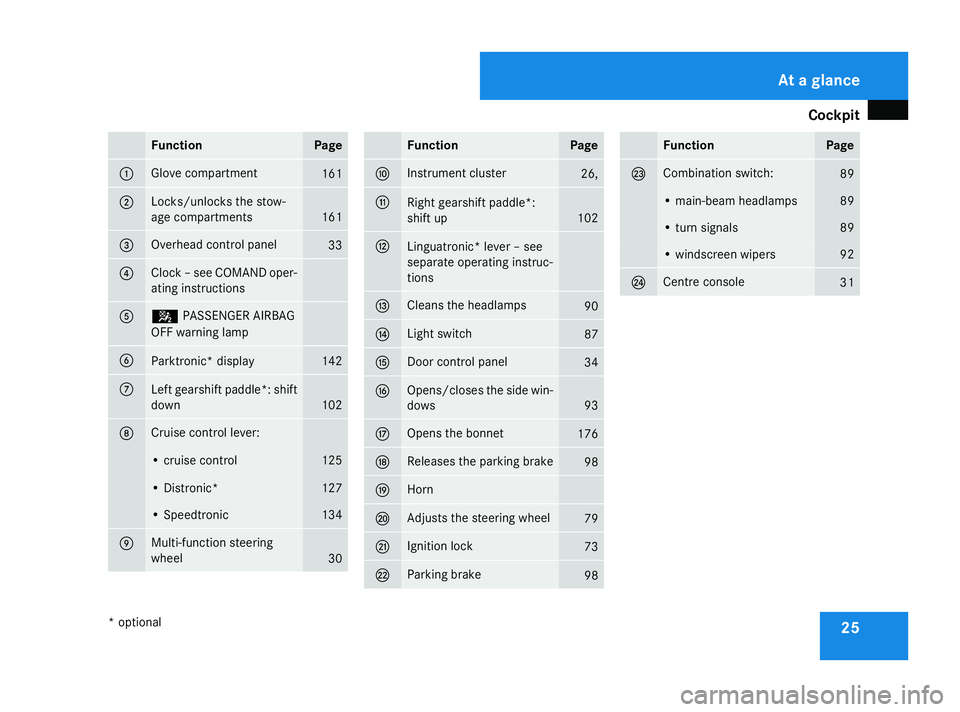
Cockpit
25Function Page
1 Glov
ecom partment 161
2 Locks/unlocks th
estow-
age compartments 161
3 Overhead control panel
33
4 Cloc
k–s ee COMAND oper-
ating instructions 5 5
PASSENGER AIRBAG
OF Fw arning lamp 6
Parktronic* display 142
7
Lef
tgearshif tpaddle *: shift
down 102
8 Cruise control lever:
•c
ruise control 125
•D
istronic* 127
•S
peedtronic 134
9 Multi-function steering
wheel
30 Function Page
a Instrumen
tcluster 26,
b
Right gearshift paddle*:
shift up 102
c
Linguatronic
*lever –see
separat eoperating instruc-
tions d Cleans the headlamps
90
e Light switch
87
f Doo
rcontrol panel 34
g Opens/closes the side win-
dows
93
h Open
sthe bonnet 176
j Releases the parking brake
98
k Horn
l Adjusts the steerin
gwheel 79
m Ignition lock
73
n Parking brake
98 Function Page
o Combination switch:
89
•m
ain-beam headlamps 89
•t
urns ignals 89
•w
indscreen wipers 92
p Centre console
31At
ag lance
*o ptional
230_AKB; 5; 4, en-GB
bjanott
,V ersion: 2.9.6
2008-04-08T15:09:54+02:00
-Seite 25 Dateiname: 6515_3089_02_buchblock.pdf; preflight
Page 33 of 317
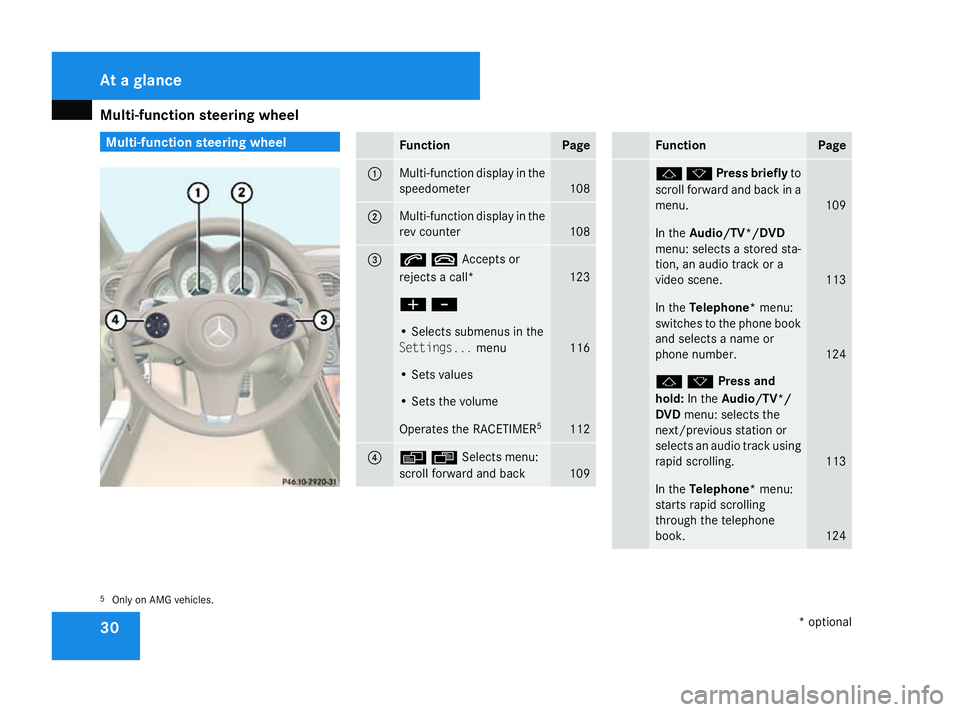
Multi-function steering wheel
30 Multi-function steering wheel
Function Page
1 Multi-function display in the
speedometer
108
2 Multi-function display in the
rev counter
108
3 st
Accepts or
rejects acall* 123
æ
- •S
elect ssubme nusint he
Settings... menu 116
•S
etsv alues •S
etst he volume Operates the
RACETIMER5 112
4 èÿ
Selects menu:
scrol lforward an dback 109 Function Page
jk
Press briefly to
scroll forward and back in a
menu. 109
In the
Audio/TV*/DVD
menu: selects astored sta-
tion, an audio track or a
video scene. 113
In the
Telephone* menu:
switches to the phone book
and selects aname or
phone number. 124
jk
Press and
hold: In the Audio/TV*/
DVD menu: selects the
next/previous station or
selects an audio track using
rapids crolling. 113
In the
Telephone* menu:
starts rapids crolling
through the telephone
book. 124
5 Only on AMG vehicles. At
ag lance
*optional
230_AKB; 5; 4, en-GB
bjanott, Version: 2.9.6 2008-04-08T15:09:54+02:00-Seite 30 Dateiname: 6515_3089_02_buchblock.pdf; preflight
Page 37 of 317
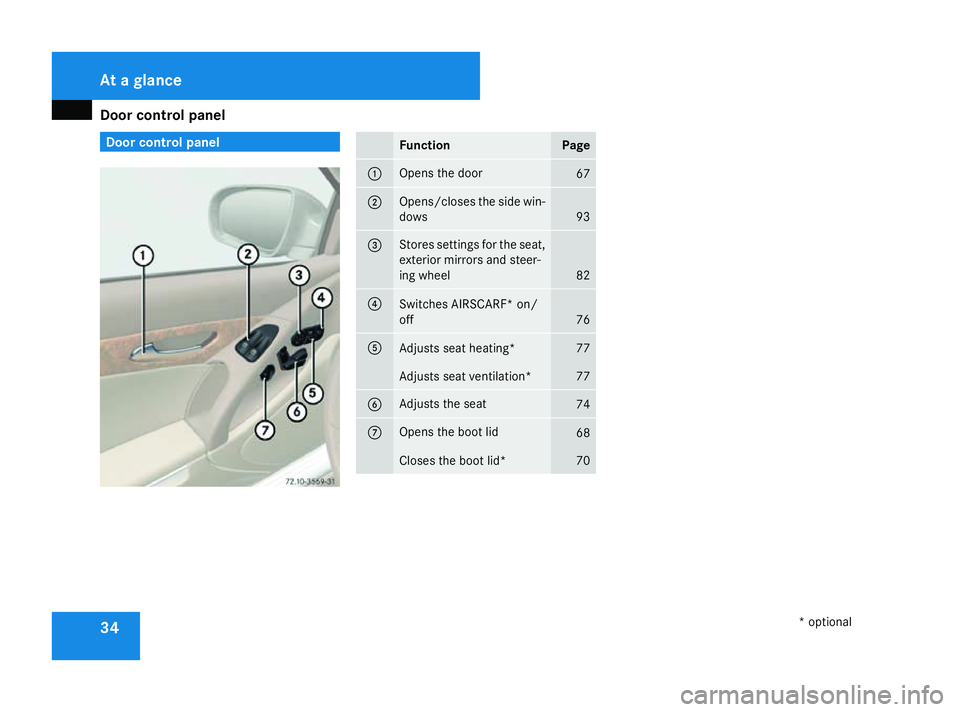
Door cont
rol panel 34 Door contro
lpanel Function Page
1 Open
sthe door 67
2 Opens/closes th
eside win-
dows 93
3 Stores settings for th
eseat,
exterio rmirror sand steer-
ing wheel 82
4
Switche
sAIRSCARF* on/
off 76
5
Adjust
sseat heating* 77
Adjust
sseat ventilation* 77
6 Adjust
sthe seat 74
7 Open
sthe boot lid 68
Closes th
eboot lid* 70At
ag lance
*optional
230_AKB
;5;4,en-GB
bjanott, Version:2.9.6
2008-04-08T15:09:54+02:00
-Seite 34 Dateiname: 6515_3089_02_buchblock.pdf; preflight
Page 43 of 317

Occupant safety
40 Occupant safety
Notes on occupant safety
Seat belts, together with belt tensioners ,belt
forc elimiters and airbags, are coordinated
restraint systems .They reduce the risk of
injury in defined acciden tsituation sand
thereby increase occupant safety. However,
seat belts and airbags generally do not pro-
tec tagainst objects penetratin gthe vehicle
from the outside.
To ensure that the restraint systems can
deliver their full potential protection ,you
should ensure that:
R the seat and head restraint are adjusted
properly (Y page 74)
R the seat belt has been fastened properly
(Y page 83)
R the airbags can inflat eproperly if they are
deployed (Y page 43)
R the steering wheel is adjusted properly
(Y page 78)
R the restraint systems have not been modi-
fied
i An airbag increases the protection of
vehicle occupants wearing aseat belt. However, airbags are only an additional
restraint system which complements, but
does not replace, the seat belt. All vehicle
occupants must wear their seat belt cor-
rectly at all times, even if the vehicle is
equipped with airbags. This is because
-on
the one hand -airbags are not deployed in
all types of accident, as in some situations
airbag deployment would not increase the
protection afforded to vehicle occupants,
provided they are wearing their seat belt
correctly. On the other hand, airbag deploy-
ment only provides increased protection if
the seat belt is worn correctly because:
R the seat belt helps to keep the vehicle
occupant in the best position in relation
to the airbag
R for example, in ahead-on collision, the
seat belt can more adequately prevent
the occupant from being propelled
towards the forc eofthe impact ,and is
thus better suited to preven tinjury
Therefore, in acciden tsituation swhere an
airbag is deployed, it only provides protec-
tion in addition to the seat belt if the seat
belt is being worn correctly. G
Risk of accident and injury
Always have maintenanc ework carried out
at aq ualified specialist workshop which
has the necessary specialist knowledge
and tools to carry out the work required.
Mercedes-Benz recommends that you use
aM ercedes-Benz Service Centr efor this
purpose.
In particular, work relevant to safety or on
safety-related systems must be carried out
at aq ualified specialist workshop. If this
work is not carried out correctly, the oper-
ating safety of your vehicle may be affec-
ted. There is arisk of an acciden tand injury. G
Risk of injury
The restraint system may not work as inten-
ded if the following component shave been
modified or work on these component shas
not been performed correctly:
R restraint system, consistin gofthe seat
belts and anchorages, belt tensioners,
belt forc elimiters ,airbags
R wiring
R networked electronic systems
Airbags or belt tensioners could then fail,
e.g. in the event of an acciden tinwhich the Safety
230_AKB
;5;4,en-GB
bjanott, Version:2.9.6
2008-04-08T15:09:54+02:0
0-Seite 40 Dateiname: 6515_3089_02_buchblock.pdf; preflight
Page 47 of 317
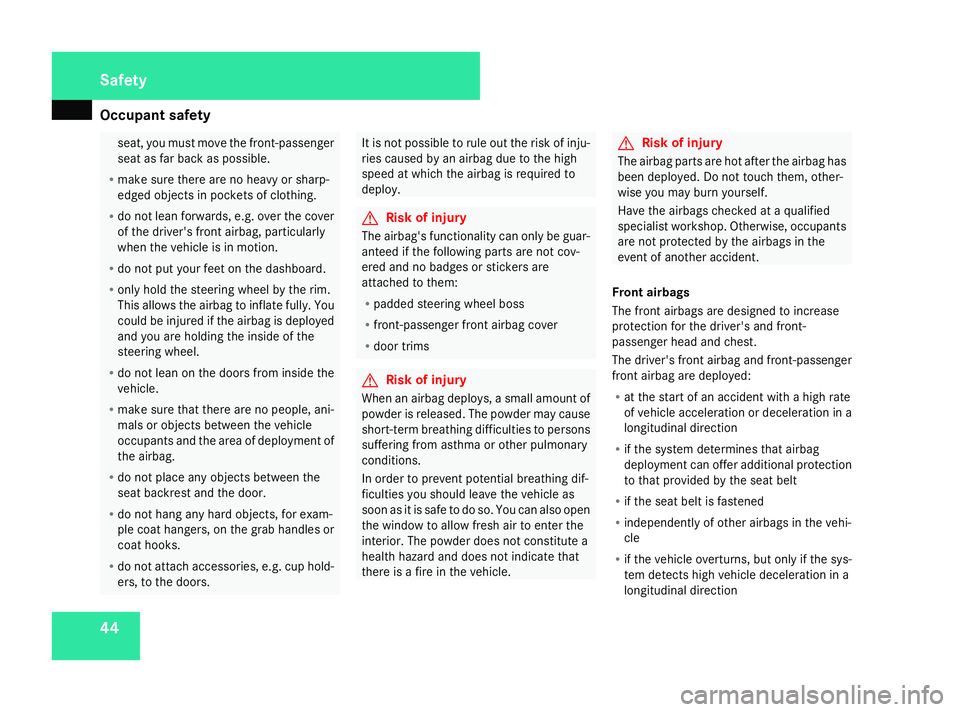
Occupant safety
44 seat, you must move the front-passenger
seat as far back as possible.
R make sure ther eare no heavy or sharp-
edged objects in pockets of clothing.
R do not lean forwards, e.g. over the cover
of the driver's fron tairbag, particularly
when the vehicle is in motion.
R do not put your feet on the dashboard.
R only hold the steering wheel by the rim.
This allows the airbag to inflat efully. You
could be injured if the airbag is deployed
and you are holding the inside of the
steering wheel.
R do not lean on the doors from inside the
vehicle.
R make sure that ther eare no people, ani-
mals or objects between the vehicle
occupants and the area of deployment of
the airbag.
R do not place any objects between the
seat backrest and the door.
R do not hang any hard objects, for exam-
ple coat hangers, on the grab handles or
coat hooks.
R do not attach accessories, e.g. cup hold-
ers, to the doors. It is not possible to rule out the risk of inju-
ries caused by an airbag due to the high
speed at which the airbag is required to
deploy. G
Risk of injury
The airbag's functionality can only be guar-
anteed if the following parts are not cov-
ered and no badges or stickers are
attached to them:
R padded steering wheel boss
R front-passenger fron tairbag cover
R door trims G
Risk of injury
When an airbag deploys, asmall amount of
powder is released. The powder may cause
short-term breathin gdifficulties to persons
sufferin gfrom asthma or other pulmonary
conditions.
In order to preven tpotential breathin gdif-
ficulties you should leave the vehicle as
soon as it is safe to do so. You can also open
the window to allow fresh air to enter the
interior. The powder does not constitute a
health hazard and does not indicat ethat
ther eisaf ire in the vehicle. G
Risk of injury
The airbag parts are hot after the airbag has
been deployed. Do not touch them ,other-
wise you may burn yourself.
Have the airbags checked at aqualified
specialist workshop. Otherwise, occupants
are not protected by the airbags in the
event of another accident.
Front airbags
The fron tairbags are designed to increase
protection for the driver's and front-
passenger head and chest.
The driver's fron tairbag and front-passenger
fron tairbag are deployed:
R at the start of an acciden twith ahigh rate
of vehicle acceleration or deceleration in a
longitudinal direction
R if the system determines that airbag
deployment can offer additional protection
to that provided by the seat belt
R if the seat belt is fastened
R independently of other airbags in the vehi-
cle
R if the vehicle overturns, but only if the sys-
tem detects high vehicle deceleration in a
longitudinal direction Safety
230_AKB
;5;4,en-GB
bjanott, Version:2.9.6
2008-04-08T15:09:54+02:0
0-Seite 44 Dateiname: 6515_3089_02_buchblock.pdf; preflight
Page 48 of 317
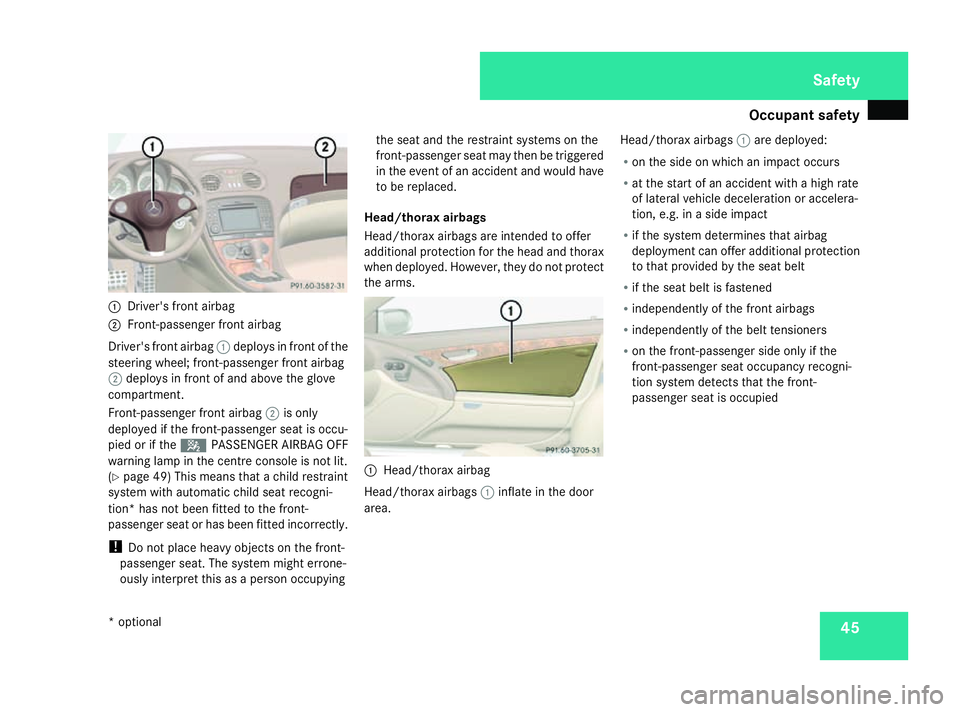
Occupant safety
451
Driver's front airbag
2 Front-passenger front airbag
Driver's front airbag 1deploysinf ront of the
steering wheel; front-passenger front airbag
2 deploysinf ront of and above the glove
compartment.
Front-passenger front airbag 2is only
deployed if the front-passenger seat is occu-
pied or if the 5PASSENGER AIRBAG OFF
warning lamp in the centre console is not lit.
(Y page 49) This means that achild restraint
system with automatic child seat recogni-
tion* has not been fitted to the front-
passenger seat or has been fitted incorrectly.
! Do not place heavy objectsont he front-
passenger seat. The system might errone-
ously interpret this as aperson occupying the seat and the restraint systems on the
front-passenger seat may then be triggered
in the event of an accident and would have
to be replaced.
Head/thoraxa irbags
Head/thorax airbags are intended to offer
additional protection for the head and thorax
when deployed. However, they do not protect
the arms. 1
Head/thorax airbag
Head/thorax airbags 1inflate in the door
area. Head/thorax airbags
1are deployed:
R on the side on which an impact occurs
R at the start of an accident with ahigh rate
of lateral vehicle deceleration or accelera-
tion, e.g. in aside impact
R if the system determines that airbag
deployment can offer additional protection
to that provided by the seat belt
R if the seat belt is fastened
R independently of the front airbags
R independently of the belt tensioners
R on the front-passenger side only if the
front-passenger seat occupancy recogni-
tion system detectst hat the front-
passenger seat is occupied Safety
*o ptional
230_AKB; 5; 4, en-GB
bjanott
,V ersion: 2.9.6
2008-04-08T15:09:54+02:00
-Seite 45 ZDateiname: 6515_3089_02_buchblock.pdf; preflight